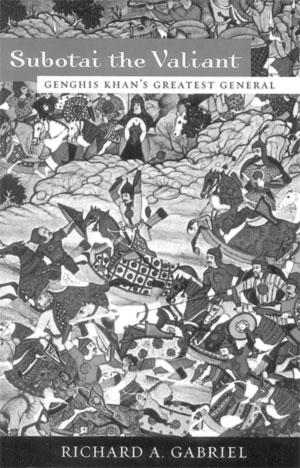Book review: Subotai an overlooked Mongol military genius
Published 12:00 am Sunday, January 22, 2006

- Subotai the Valiant: Genghis Khan's Greatest General, by Richard A. Gabriel. New York: Praeger Publishers, 2004. 164 + xii pages, $35 (cloth).
Subotai conquered 32 nations and won 65 battles, a record that equals Alexander the Great and Napoleon. Yet, few have heard of him and little is written about his remarkable career. No commander in history equaled his ability to seize the offensive and maintain operations over such a period of time.
Subotai was the son of a blacksmith, a member of the forest-dwelling Uriangkhai tribe, a relative of the steppe-dwelling Mongols. He joined the forces of Temujin (Genghis Khan) when he was 14 and rose from bodyguard to trusted lieutenant during the battles for consolidation waged between 1188 and 1206. He received his first independent command in 1197 when he was 22. Charged with destroying the Merkets, the last holdouts against Genghis Khan, he devastated their villages, annihilated the remnants of their army and hunted down their leaders.
In 1211, the Mongols attacked China and Subotai was in command of one of the main forces. After breaching the Great Wall, the Mongols outmaneuvered the Chinese army and destroyed it at the Battle of Shan-si, but were unable to force the Chin government to surrender. The vast resources of China, combined with its extensive fortifications, made it impossible for the Mongols to carry out the short, devastating campaigns they previously waged.
While the Mongol army marched back and forth across much of northern China, destroying everything in its path, Subotai was detached to punish Manchuria, the original home of the Chin, who ruled China. After a quick, destructive campaign, Subotai suddenly crossed the Yalu River and invaded Korea, who quickly agreed to become vassals of the Mongols. They later changed their minds and 30 years of intermediate warfare resulted.
Genghis Khan died in 1227 and his son, Ogedai, was elected to succeed him. Subotai was placed in command of a renewed invasion of China, which resulted in the destruction of the Chin dynasty in 1234 with the capture of the capital at Kai-fung-fu.
During the period of peace in the war against the Chin, the Mongols attacked the Muslim empire of Khwarismian in Central Asia, which controlled most of the old spice road and the great cities of Bokhara and Samarkand, and Subotai was in command of one wing of the Mongol army. In one of the most incredible military campaigns in history, crossing deserts and mountains in the dead of winter, the Mongols destroyed Shah Mohammed II’s army and conquered Khwarismian in two years (1220-1221). The Mongol army probably numbered no more than 150,000 men.
As the campaign ended, Subotai moved a force of about 30,000 men westward through the Caucasus into Georgia. It was a large-scale cavalry raid, not a war of conquest. Defeating the Georgian and Russian armies in a dozen battles and gaining valuable intelligence, Subotai’s force covered over 5,500 miles before returning to Mongolia in 1224.
In December 1237, Subotai began his last campaign, invading Russia, then Bulgaria, Hungary and finally moving toward Vienna in 1242, when he suddenly halted the advance and returned to Mongolia for the election of a new leader. Subotai retired to his yak farm and spent the remainder of his life with his family, dying at the age of 72.
Because of the lack of sources and especially biographical information about Subotai, “Subotai the Valiant” is basically a study of the military operations directed by Subotai, with very little personal information. There are no Mongol sources except for the “Secret History of the Mongols,” which is questionable at best. Subotai was brilliant, ruthless (he ordered the deaths of thousands of prisoners and helpless civilians) and a shrewd diplomat when he had to be. In essence, he was a Mongol warrior who was more interested in fighting and destroying than in building and governing an empire. “Subotai the Valiant” is a fascinating book on a subject long neglected by military historians.





